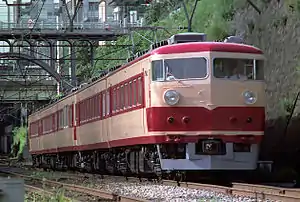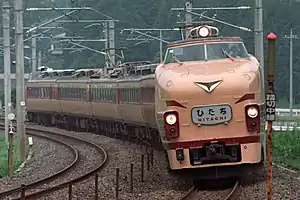157 series
The 157 series (157系) was a Japanese DC electric multiple unit (EMU) train type operated on limited express services by Japanese National Railways (JNR) from 1959 until 1980.
| 157 series | |
|---|---|
 A 157 series EMU on an imperial train working, June 1978 | |
| In service | September 1959–1980 |
| Manufacturer | Kawasaki Sharyo, Kisha Seizo, Nippon Sharyo |
| Constructed | 1959–1963 |
| Number built | 32 vehicles |
| Number in service | None |
| Number preserved | 1 vehicle |
| Number scrapped | 31 vehicles |
| Operator(s) | JNR |
| Depot(s) | Tamachi |
| Specifications | |
| Car body construction | Steel |
| Traction system | Resistor control |
| Traction motors | MT46 |
| Power output | 100kW |
| Transmission | Gear Ratio: 1:4.21 (19:80) |
| Electric system(s) | 1,500 V DC |
| Current collector(s) | Overhead wire |
| Track gauge | 1,067 mm (3 ft 6 in) |
Operations
The 157 series EMUs were first introduced by JNR on Nikkō semi express services between Tokyo and Nikkō on 22 September 1959 to counter competition from the private company Tobu Railway, which also operated trains to Nikkō.[1] They were also used on Chusenji services between Shinjuku and Nikkō, and Nasuno services between Ueno and Kuroiso.[2]
157 series EMUs were also introduced on seasonal Hibiki services on the Tokaido Main Line from 21 November 1959, and were later used on Amagi and Soyokaze services.[1]
 A 157 series set on a Hibiki limited express service in the 1970s
A 157 series set on a Hibiki limited express service in the 1970s A 157 series set on a Shirane limited express service from Ueno, August 1974
A 157 series set on a Shirane limited express service from Ueno, August 1974
Fleet details
External livery
Initially painted in the JNR livery of beige ("Cream No. 4") and crimson ("Red No. 11"), the red colour was later changed to a slightly darker shade ("Red No. 2") when the sets were modified with the addition of air-conditioning.[2]
KuRo 157-1 imperial train car
The 157 series fleet included a dedicated imperial train car, built by Kawasaki Sharyo (present-day Kawasaki Heavy Industries) and delivered in June 1960.[4] Numbered KuRo 157-1, the car could be inserted into 157 series formations for use on imperial train workings.[5] One end had a gangwayed driving cab based on the 153 series EMU design, although the car was normally sandwiched in the middle of a 157 series formation, and was only very rarely used with the driving cab leading.[4] In 1979, the car was modified for use in conjunction with 183 series EMUs, with the first official working on 2 July 1980.[4] From March 1985, it was repainted in cream with a green stripe for use in conjunction with 185 series EMUs.[4]
The last official operation of the car was on 8 September 1993.[4]
Following retirement, the KuRo 157-1 car remained in storage at Tamachi Depot for many years, but was moved to Tokyo General Rolling Stock Centre in the early hours of 2 December 2012.[6]
 The dedicated imperial train car KuRo 157-1, June 1977
The dedicated imperial train car KuRo 157-1, June 1977 The imperial train car KuRo 157-1 sandwiched in a 183 series set, August 1980
The imperial train car KuRo 157-1 sandwiched in a 183 series set, August 1980
History
The first 157 series set was delivered in August 1959, and entered service on Nikkō semi express services between Tokyo and Nikkō from 22 September 1959.[2] Air-conditioning was added to the trains from 1962.[7]
With the exception of the special imperial train car KuRo 157-1, the entire fleet of 157 series trains was withdrawn by 1980.[2]
Fleet details
The individual car histories are as follows.[8]


| Car No. | Manufacturer | Delivery date | Withdrawal date |
|---|---|---|---|
| KuMoHa 157 | |||
| KuMoHa 157-1 | Kisha | 26 August 1959 | 28 November 1980 |
| KuMoHa 157-2 | Kisha | 26 August 1959 | 28 November 1980 |
| KuMoHa 157-3 | Kisha | 26 August 1959 | 15 October 1976 |
| KuMoHa 157-4 | Nippon Sharyo | 15 August 1959 | 28 June 1976 |
| KuMoHa 157-5 | Nippon Sharyo | 15 August 1959 | 15 October 1976 |
| KuMoHa 157-6 | Nippon Sharyo | 12 December 1959 | 20 July 1976 |
| KuMoHa 157-7 | Nippon Sharyo | 15 December 1960 | 20 July 1976 |
| KuMoHa 157-8 | Nippon Sharyo | 15 December 1960 | 28 June 1976 |
| KuMoHa 157-9 | Kawasaki Sharyo | 12 December 1960 | 28 June 1976 |
| KuMoHa 157-10 | Kawasaki Sharyo | 12 December 1960 | 15 October 1976 |
| MoHa 156 | |||
| MoHa 156-1 | Kisha | 26 August 1959 | 28 November 1980 |
| MoHa 156-2 | Kisha | 26 August 1959 | 28 November 1980 |
| MoHa 156-3 | Kisha | 26 August 1959 | 15 October 1976 |
| MoHa 156-4 | Nippon Sharyo | 15 August 1959 | 28 June 1976 |
| MoHa 156-5 | Nippon Sharyo | 15 August 1959 | 15 October 1976 |
| MoHa 156-6 | Nippon Sharyo | 12 December 1959 | 20 July 1976 |
| MoHa 156-7 | Nippon Sharyo | 15 December 1960 | 20 July 1976 |
| MoHa 156-8 | Nippon Sharyo | 15 December 1960 | 28 June 1976 |
| MoHa 156-9 | Kawasaki Sharyo | 12 December 1960 | 28 June 1976 |
| MoHa 156-10 | Kawasaki Sharyo | 12 December 1960 | 15 October 1976 |
| SaHa 157 | |||
| SaHa 157-1 | Kisha | 26 August 1959 | 20 July 1976 |
| SaHa 157-2 | Nippon Sharyo | 15 August 1959 | 15 October 1976 |
| SaHa 157-3 | Nippon Sharyo | 15 December 1959 | 20 July 1976 |
| SaHa 157-4 | Kawasaki Sharyo | 12 December 1960 | 15 October 1976 |
| SaHa 157-5 | Kawasaki Sharyo | 12 December 1960 | 15 October 1976 |
| SaRo 157 | |||
| SaRo 157-1 | Kisha | 26 August 1959 | 20 July 1976 |
| SaRo 157-2 | Nippon Sharyo | 15 August 1959 | 28 June 1976 |
| SaRo 157-3 | Nippon Sharyo | 15 December 1959 | 20 July 1976 |
| SaRo 157-4 | Kawasaki Sharyo | 12 December 1960 | 20 July 1976 |
| SaRo 157-5 | Kawasaki Sharyo | 12 December 1960 | 28 June 1976 |
| SaRo 157-6 | Nippon Sharyo | 18 March 1963 | 28 June 1976 |
| KuRo 157 | |||
| KuRo 157-1 | Kawasaki Sharyo | 8 July 1960 | |
References
- Ogano, Minoru (March 2011). 新幹線・特急大図鑑2011 [Shinkansen & Limited Express Directory 2011]. Japan: JTB Publishing. p. 132. ISBN 978-4-533-08193-4.
- Fukuhara, Shunichi (March 2013). "国鉄157系を振り返る" [Looking back at the JNR 157 series]. Japan Railfan Magazine (in Japanese). 53 (623): 97–101.
- 写真とイラストで見る国鉄急行型電車のすべて [JNR Express EMUs in pictures]. Japan: Neko Publishing Ltd. 29 November 2013. pp. 36–39. ISBN 978-4-7770-1532-0.
- Okada, Seiichi (January 2007). "1号御料車とクロ157" [Imperial Carriage No. 1 and KuRo 157]. Japan Railfan Magazine (in Japanese). 47 (549): 9–31.
- JR全車輌ハンドブック2009 [JR Rolling Stock Handbook 2009]. Japan: Neko Publishing. 2009. p. 140. ISBN 978-4-7770-0836-0.
- "12/2, クロ157-1・クモヤ145-114が東京総合車両センターへ" [KuRo 157-1 and KuMoYa 145-114 moved to Tokyo General Rolling Stock Centre]. Japan Railfan Magazine. 53 (622): 162. February 2013.
- Teramoto, Mitsuteru (July 2001). 国鉄・JR列車名大辞典 [JNR & JR Train Name Encyclopedia]. Tokyo, Japan: Chuoshoin Publishing Co., Ltd. pp. 424–425. ISBN 978-4-88732-093-2.
- JR電車編成表 2016冬 [JR EMU Formations – Winter 2016] (in Japanese). Japan: Kotsu Shimbunsha. 18 November 2015. pp. 385–386. ISBN 978-4-330-62315-3.
